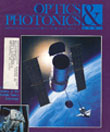
March 1990 Issue
Feature Articles
The optical designs of the HST scientific instruments
The primary optics of the Hubble Space Telescope provide a 39,000 cm2 clear light collecting area and a useful spectral bandpass ranging from 110 to at least 4,000 nm. Above the turbulence of the Earth's atmosphere, the telescope's image quality will be limited only by its 2.4 m aperture and by residual aberrations, primarily astigmatism and field curvature. On-axis point source images will achieve 60% encircled energy within a radius of 0.05 to 0.09 seconds of arc from red wavelengths to the vacuum ultraviolet.
Key role of standards in international communications
Perhaps you wonder what standards have to do with your daily life and the world around you. You may grudgingly admit there are some economic and/or safety benefits, but find it difficult to see standards playing a profound role in world affairs.
by Robert E. ParksSeeing in the light and in the dark
The human eye is remarkably sensitive. The first stage in the process of seeing is the absorption of light in cells called rods and cones, which lie in the retina, a thin sheet of tissue at the back of the eye. The retina records the image of the world around you somewhat like film does in a camera. Light is composed of small packets of energy called photons, and the eye is so sensitive that the absorption of a single photon is all that is required to stimulate a single rod photoreceptor.
by David R. WilliamsThe history and promise of the Hubble Space Telescope
The Hubble Space Telescope (HST) is now ready to be bundled on the Space Shuttle Discovery. Preparations are being made to deploy it into a circular orbit 610 km above the Earth's surface, where it will begin its duties as the world's premier optical astronomical observatory.
by Albert Boggess and David S. Leckrone

![Manual probe system with needles for test of semiconductor on silicon wafer. [A. Morozov / Getty]](https://opnmedia.blob.core.windows.net/$web/opn/media/images/articles/2025/1125/departments/202511-cover-web.jpg?ext=.jpg)
![Researcher Clara Saraceno in the lab. [Image by Carsten Behler Photography]](https://opnmedia.blob.core.windows.net/$web/opn/media/images/articles/2025/1025/departments/202510-cover-web.jpg?ext=.jpg)
